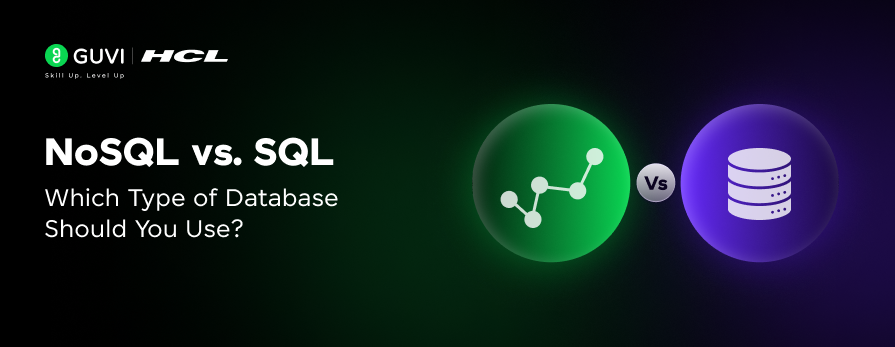![Consistency in DBMS: ACID Properties For Data Integrity [2025] 1 Post thumbnail](https://www.guvi.in/blog/wp-content/uploads/2024/06/Feature-Image-1-3.png)
Consistency in DBMS: ACID Properties For Data Integrity [2025]
Mar 04, 2025 5 Min Read 6945 Views
(Last Updated)
To ensure reliable data integrity in Database Management Systems (DBMS), understanding ACID properties is crucial.
ACID stands for Atomicity, Consistency, Isolation, and Durability. These properties are fundamental to maintaining the stability and correctness of transactions within a database.
In this article, we study the importance of ACID properties, particularly focusing on how consistency ensures the accuracy and reliability of data in DBMS environments.
Table of contents
- 1) Understanding ACID Properties
- 1) Introduction to ACID Properties in DBMS
- 2) Importance of ACID Properties for Data Integrity
- 2) Unpacking Consistency in DBMS
- 1) Definition of Consistency in DBMS
- 2) Role of Consistency in Ensuring Data Integrity
- 3) Maintaining Consistency
- 1) Techniques for Achieving Consistency
- 2) Challenges in Maintaining Consistency
- 4) Benefits of Consistency in DBMS
- 1) Ensuring Reliable Transactions
- 2) Enhancing Data Quality and Reliability
- Takeaways...
- FAQs
- What is integrity in ACID properties?
- What is the ACID test for data integrity?
- What are the 4 ACID properties of DBMS?
- What is data integrity in DBMS?
1) Understanding ACID Properties
To ensure reliable data integrity in Database Management Systems (DBMS), understanding ACID properties is crucial. ACID stands for Atomicity, Consistency, Isolation, and Durability. These properties are fundamental to maintaining the stability and correctness of transactions within a database.
![Consistency in DBMS: ACID Properties For Data Integrity [2025] 2 ACID properties in DBMS](https://www.guvi.in/blog/wp-content/uploads/2024/09/Image-1-1-3.png)
1.1) Introduction to ACID Properties in DBMS
The ACID properties are designed to guarantee that database transactions are processed reliably and ensure data integrity. Here’s a quick overview:
![Consistency in DBMS: ACID Properties For Data Integrity [2025] 3 ACID](https://www.guvi.in/blog/wp-content/uploads/2024/09/Image-2-1-4.png)
- Atomicity: Ensures that all operations within a transaction are completed successfully. If any part of the transaction fails, the entire transaction is rolled back.
- Consistency: Ensures that a transaction brings the database from one valid state to another, maintaining database rules and constraints.
- Isolation: Ensures that transactions are executed independently of one another, preventing concurrent transactions from interfering with each other.
- Durability: Ensures that once a transaction has been committed, it remains so, even in the event of a system failure.
Before diving into the next section, ensure you’re solid on full-stack development essentials like front-end frameworks, back-end technologies, and database management. If you are looking for a detailed Full Stack Development career program, you can join GUVI’s Full Stack Development Career Program with Placement Assistance. You will be able to master the MERN stack (MongoDB, Express.js, React, Node.js) and build real-life projects.
Additionally, if you want to explore MySQL through a self-paced course, try GUVI’s self-paced MySQL course.
1.2) Importance of ACID Properties for Data Integrity
Each ACID property plays a critical role in maintaining data integrity and reliability in a DBMS. Here’s how:
- Atomicity: Prevents partial updates to the database, ensuring that either all operations are completed or none are. This prevents corruption caused by incomplete transactions.
- Consistency: Guarantees that only valid data following all rules and constraints is saved in the database. This helps in maintaining the correctness of the database state.
- Isolation: Prevents data anomalies by ensuring transactions do not affect each other. This is essential for the accuracy of concurrent transactions.
- Durability: Ensures the permanence of committed transactions, which is necessary for the reliability of the database over time.
Understanding these properties helps you grasp the mechanisms that ensure reliable transactions and data quality in DBMS environments. By mastering these concepts, students and tech professionals can better manage and optimize database systems.
Also Explore: Top 10 Data Integration Project Ideas
2) Unpacking Consistency in DBMS
Consistency in DBMS is a core concept within the ACID properties framework, essential for maintaining reliable data integrity. Let’s delve into what consistency means and its role in ensuring the accuracy and reliability of your data.
2.1) Definition of Consistency in DBMS
Consistency means that any transaction in a database must transition from one valid state to another. When a transaction is completed, the database must remain in a consistent state, adhering to all defined rules, constraints, and triggers.
If a transaction violates these rules, it will be rolled back, ensuring no partial changes are saved.
For instance, consider a banking system where a transfer of funds between accounts must respect the rule that the total amount of money remains constant.
The database would be inconsistent if a transaction subtracts an amount from one account but fails to add it to the recipient’s account. Consistency ensures that such discrepancies do not occur, maintaining the integrity of your data.
Also Read: Mastering Database Management: A Beginner’s Guide 2025
2.2) Role of Consistency in Ensuring Data Integrity
Consistency plays a pivotal role in ensuring data integrity in a Database Management System (DBMS). By enforcing rules and constraints, a consistent state guarantees that all data remains accurate and trustworthy after any transaction.
![Consistency in DBMS: ACID Properties For Data Integrity [2025] 4 Data Integrity in management](https://www.guvi.in/blog/wp-content/uploads/2024/09/Image-3-1-3.png)
This is crucial for applications that require high reliability, such as financial systems, e-commerce platforms, and healthcare databases. Consider the following table illustrating the impact of consistency on data integrity:
| Transaction Type | Initial State | Transaction Outcome | Final State (Consistent) | Final State (Inconsistent) |
|---|---|---|---|---|
| Fund Transfer | A: $100, B: $50 | A: -$30, B: +$30 | A: $70, B: $80 | A: $70, B: $50 |
| Inventory Update | Item X: 20 units | Item X: -5 units | Item X: 15 units | Item X: 20 units |
| Order Processing | Order: Pending | Order: Completed | Order: Shipped | Order: Pending |
In each scenario, the consistent final state reflects accurate and reliable data, while an inconsistent state indicates potential errors and data integrity issues.
These resources will provide more context on the interconnectedness of these properties and their collective role in maintaining a robust database system.
3) Maintaining Consistency
3.1) Techniques for Achieving Consistency
Consistency in DBMS ensures that only valid data is written to the database, preserving the integrity of the dataset. There are several techniques to achieve consistency in a database management system:
- Constraints: Constraints enforce rules on the data in the database tables. They include primary keys, foreign keys, unique constraints, and check constraints. These rules ensure that the data adheres to the defined standards.
- Normalization: Normalization organizes data to reduce redundancy and improve data integrity. It involves structuring the database into tables and establishing relationships between them, ensuring that data is stored logically.
- Transactions: Transactions are sequences of operations performed as a single unit of work. They follow the ACID properties, ensuring that all operations within a transaction are completed successfully before being committed to the database. If any operation fails, the entire transaction is rolled back, maintaining consistency.
- Triggers: Triggers are automated actions that are executed in response to certain events on a table or view. They can enforce complex business rules and ensure that data modifications adhere to the defined consistency rules.
- Stored Procedures: Stored procedures are precompiled collections of SQL statements that can be executed as a single unit. They can help maintain consistency by encapsulating complex logic and enforcing business rules.
Also Read: Mastering Database Optimization: Advanced Indexing Techniques for Performance [2025]
3.2) Challenges in Maintaining Consistency
Maintaining consistency in a DBMS can be challenging due to various factors:
- Concurrency Control: Concurrency control manages simultaneous operations without conflict, ensuring consistency. However, handling multiple transactions that access the same data concurrently can lead to issues such as deadlocks and race conditions.
- Distributed Databases: In distributed databases, data is stored across multiple locations. Ensuring consistency across these locations can be difficult due to network latency, data replication issues, and node failures.
- Data Anomalies: Data anomalies, such as insertion, update, and deletion anomalies, can occur when data is not properly normalized. These anomalies can lead to inconsistencies in the database.
- Complex Business Rules: Enforcing complex business rules can be challenging, especially when they involve multiple tables and relationships. Ensuring that all rules are consistently applied requires careful database design and implementation.
- Hardware and Software Failures: Hardware and software failures can disrupt database operations, leading to inconsistencies. Implementing robust backup and recovery mechanisms is essential to mitigate these risks.
By understanding and addressing these challenges, you can ensure that your database maintains consistency, thereby enhancing data integrity and reliability.
4) Benefits of Consistency in DBMS
4.1) Ensuring Reliable Transactions
Consistency in DBMS is crucial for reliable transactions. It ensures that a database moves from one valid state to another, preserving data integrity throughout the process.
When you execute a transaction, the DBMS checks that all constraints, such as primary keys, foreign keys, and unique constraints, are satisfied. This prevents invalid data from being written to the database.
For example, if you have a transaction that involves debiting one account and crediting another, consistency guarantees that both operations either complete successfully or do not occur at all.
This prevents scenarios where money could be debited from one account without being credited to another, ensuring accurate and reliable transactions.
4.2) Enhancing Data Quality and Reliability
Consistency also enhances data quality and reliability by enforcing rules and constraints on the data. This ensures that the data stored in the database adheres to the defined standards, making it dependable for analysis and reporting.
For instance, consider a database that stores customer information. Consistency ensures that each customer has a unique ID, valid email address, and correct phone number format.
![Consistency in DBMS: ACID Properties For Data Integrity [2025] 5 Benefits of improving data quality](https://www.guvi.in/blog/wp-content/uploads/2024/09/Image-4-1-4.png)
This level of data quality is crucial for businesses that rely on accurate customer data for operations and decision-making.
| Benefit | Description |
|---|---|
| Reliable Transactions | Ensures transitions from one valid state to another |
| Data Quality | Enforces rules and constraints for accurate data |
| Data Reliability | Makes data dependable for analysis and reporting |
By maintaining consistency, you ensure that your database remains reliable and trustworthy. It plays a key role in the overall data integrity in DBMS, working in conjunction with other ACID properties in DBMS like atomicity and durability.
Kickstart your Full Stack Development journey by enrolling in GUVI’s certified Full Stack Development Career Program with Placement Assistance where you will master the MERN stack (MongoDB, Express.js, React, Node.js) and build interesting real-life projects. Our team of experts has crafted this program to help you upskill and assist you in placements.
Alternatively, if you want to explore MySQL through a self-paced course, try GUVI’s self-paced MySQL course.
Takeaways…
Understanding ACID properties is essential for anyone involved in managing or designing databases. Each property—Atomicity, Consistency, Isolation, and Durability—plays a vital role in maintaining data integrity and reliability.
By grasping these concepts, database professionals can ensure robust transaction processing and data quality, ultimately leading to more reliable and efficient database systems.
Also Know Latest Trends With Our Comprehensive Guide on DBMS Trends in 2025
FAQs
Integrity in ACID properties refers to the correctness and consistency of data. It ensures that all transactions lead the database from one valid state to another, maintaining data accuracy and reliability.
The ACID test for data integrity ensures that database transactions are Atomic (completed in full or not at all), Consistent (maintain database rules), Isolated (transactions do not interfere with each other), and Durable (changes are permanent).
The four ACID properties of DBMS are:
1) Atomicity: Ensures all parts of a transaction are completed successfully.
2) Consistency: Ensures data follows all predefined rules.
3) Isolation: Ensures transactions do not affect each other.
4) Durability: Ensures once a transaction is committed, it remains so.
Data integrity in DBMS refers to the accuracy, consistency, and reliability of data stored in the database. It is maintained through constraints, rules, and procedures that enforce data validity and correctness.






















![Mastering Database Optimization: Advanced Indexing Techniques for Performance [2025] 7 Feature Image - Mastering Database Optimization Advanced Indexing Techniques for Performance](https://www.guvi.in/blog/wp-content/uploads/2024/04/Feature-Image-Mastering-Database-Optimization-Advanced-Indexing-Techniques-for-Performance.webp)








Did you enjoy this article?